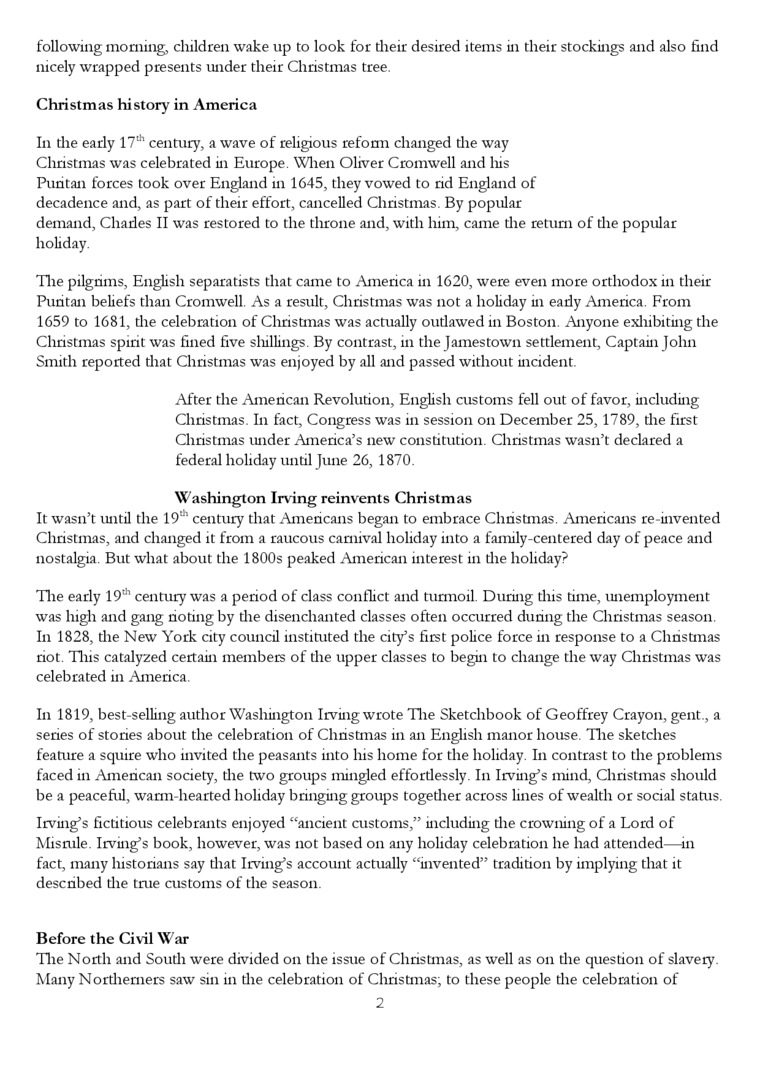107782

following moming, children wake up to look for tlieir desired items in their stockiiigs and also find nicely wrapped presents imder their Christmas tree.
Christmas hi story in America
In tlie early 17* century, a wave of religious refonn changed die way Christmas was celebrated in Europę. When 01iver Cromwell and his Puritan forces took over England in 1645, tliey vowed to rid England of decadence and, as part of their effort, cancelled Christmas. By popular
demand, Cliades II was restored to the tlirone and, witli him, came die return of die popular holiday.
The pilgrims, English separatists that came to America in 1620, were even morę orthodox in their Puritan beliefs than Cromwell. As a result, Christmas was not a holiday in eady America. From 1659 to 1681, die celebration of Christmas was actually outlawed in Boston. Anyone exlnbiting the Christmas spirit was fined five sliillings. By contrast, in the Jamestown settlement, Captain John Smith reported that Christmas was enjoyed by all and passed without incident.
After the American Revolution, English customs fell out of favor, including Christmas. In fact, Congress was in session on December 25,1789, the first Christmas imder America’s new constitution. Christmas wasn’t declared a federal holiday until June 26, 1870.
Washington Irving reiments Christmas
It wasn’t until the 19* century that Americans began to embrace Christmas. Americans re-invented Christmas, and changed it from a raucous caniival holiday into a family-centered day of peace and nostalgia But what about the 1800s peaked American interest in die holiday?
Tlie early 19* century was a period of class conflict and tunnoil. During diis time, imemployment was high and gang rioting by die disenchanted classes often occurred during the Christmas season. In 1828, die New York city council instituted the cit/s first police force in response to a Christmas riot. Tliis catalyzed certain members of die upper classes to begin to cliange the way Christmas was celebrated in America.
In 1819, best-selling autlior Washington Irving wrote Tlie Sketchbook of Geoffrey Crayon, gent., a series of stories about the celebration of Christmas in an English manor liouse. Tlie sketches feature a squire who invited the peasants into his liome for the holiday. In contrast to the problems faced in American society, die two groups nungled effordessly. In Irying^ mind, Christmas sliould be a peaceftil, warm-hearted holiday bringing groups togedier across lines of wealtli or social status.
Inring^ fictitious celebrants enjoyed “ancient customs,” mcludmg die crowmng of a Lord of Misnile. Inring^ book, however, was not based on any holiday celebration he had attended—in fact, many historians say that Inring^s account actually “invented” tradition by implying that it described die true customs of the season.
Before the Civil War
Tlie Nortli and Soudi were dwided on the issue of Christmas, as well as on die question of slavery. Many Nordiemers saw sin in die celebration of Christmas; to tliese people die celebration of
2
Wyszukiwarka
Podobne podstrony:
2 The Soviate preferred to look for freeh racruite, suoh aa Wanda osilewska for estadia. In the peri
mbs 030 MY BKEATHING SYSTEM peaceful repose they are to look for liuppiness and strcngth during the
Jhcre to look for good architccture? Significant buildings constructcd n Poland 1989-2014 ho co
* ‘Splendid’ Daily Telegraph Candia McWilliam Author of What to Look for in
calibre cover Candia McWilliam Author of What to Look for in Winter B L O : O M S B U R Y 1
Winner of the Guardian Fiction PrizeCandia McWilliam Author of What to Look for in WinterDebatableLa
‘Compelling and unsettling’ GuardianCandia«, McWilliam Author of What to Look for in WinterA Lit tle
history of blue jeans THE IIISTORY OF BLUE JEANS In 1853 a lot of people rushed to California to loo
224 (25) Diagnostic tests Once a diagnosis of ECO or SO has been madę, it is essential to look for p
226 (23) Microscopic examination of cerumen, collected with a curette or swab, can be used to look f
19vcg09 Welcome to Windows for Workgroups Micbosoft.WINDOWS. Type a logon name and password to log o
emc-naricSłowniczek pojęć FHEQ - Framework for Higher Education Oualifications in England, Wales and
więcej podobnych podstron